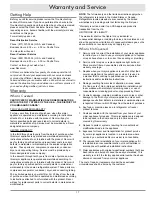
14
Troubleshooting
Refrigerator will not operate
Is the power supply cord unplugged?
Plug into a grounded
3- prong outlet.
Has a household fuse or circuit breaker tripped?
Replace
the fuse or reset the circuit breaker.
Is the main power switch OFF?
See
Turning the Main Power
Switch On/Off
on page 3.
Is the control panel power OFF?
See
Setting the Controls
on page 5.
Is the refrigerator defrosting?
Recheck to see if the
refrigerator is operating in 30 minutes. Your refrigerator will
regularly run an automatic defrost cycle.
Is the refrigerator not cooling?
Turn the power on the unit
OFF
then
ON
again to reset. See
Setting the Controls
on page
5. If this does not correct the problem, call for service.
Temperature is too warm
Are the air vents blocked in either compartment?
If cold
air movement between the compartments is obstructed,
the refrigerator and/or freezer will not cool. Remove any
objects from in front of the air vents. See
Ensuring Proper Air
Circulation
on page 5.
Are the door(s) opened often?
The refrigerator will warm
when this occurs. Keep the refrigerator cool by getting all items
out at one time, keeping food organized, and closing the door
as soon as possible.
Has a large amount of food just been added to the
refrigerator or freezer?
Adding a large amount of food warms
the refrigerator. It can take several hours for the refrigerator to
return to the normal temperature.
Are the controls set correctly for the surrounding
conditions?
See
Setting the Controls
on page 6.
Is the refrigerator not cooling?
Turn the power on the unit
OFF
then
ON
again to reset. See
Setting the Controls
on page
5. If this does not correct the problem, call for service.
Try the solutions suggested here first in order to avoid the cost of an unnecessary service call.
The refrigerator seems to make too much
noise
The sounds may be normal for your refrigerator. See
Normal
Operating Sounds
on page 5.
The motor seems to run too much
Is the room temperature hotter than normal?
The motor
will run longer under warm conditions. At normal room
temperatures, expect your motor to run about 80% of the time.
Under warmer conditions, it will run even more.
Has a large amount of food just been added to the
refrigerator?
Adding a large amount of food warms the
refrigerator. The motor normally will run longer to cool the
refrigerator back down.
Are the doors opened often?
The motor will run longer when
the doors are opened often. Conserve energy by getting all
items out at one time, keeping food organized, and closing the
door as soon as possible.
Are the controls not set correctly for the surrounding
conditions?
See
Setting the Controls
on page 6.
Are the doors not closed completely?
Close the doors
firmly. If they do not close completely, see
The doors will not
close completely
later in this section.
Are the condenser coils dirty?
This obstructs air transfer
and makes the motor work harder. Clean the condenser coils.
Refer to the
Care and Cleaning
section.
Are the door gaskets not sealed all the way around?
Contact a technician or other qualified person.
NOTE:
Your new refrigerator will run longer than your old one due
to its high-efficiency motor.
The divider between the two compartments is
warm
The warmth is probably due to normal operation of the
automatic exterior moisture control. If still concerned, call for
service.
There is interior moisture buildup
Are the air vents blocked in the refrigerator?
Remove any
objects from in front of the air vents. See
Ensuring Proper Air
Circulation
on page 5 for the location of air vents.
Are the door(s) opened often?
Avoid humidity buildup by
getting all items out at one time, keeping food organized, and
closing the door as soon as possible.
Is the room humid?
It is normal for moisture to build up inside
the refrigerator when the room air is humid.
Is the food packaged correctly?
Check that all food is
securely wrapped. Wipe off damp food containers before
placing in the refrigerator.
Are the controls set correctly for the surrounding
conditions?
See
Setting the Controls
on page 6.
Was a self-defrost cycle completed?
It is normal for droplets
to form after the refrigerator self-defrosts.
Electrical Shock Hazard
Plug into a grounded 3 prong outlet.
Do not remove ground prong.
Do not use an adapter.
Do not use an extension cord.
Failure to follow these instructions can result in death,
fire, or electrical shock.
WARNING



















